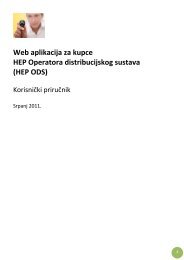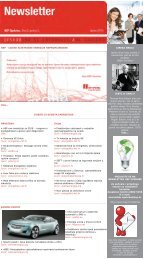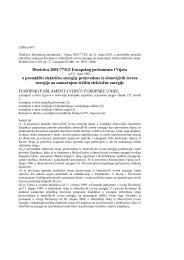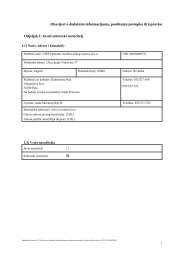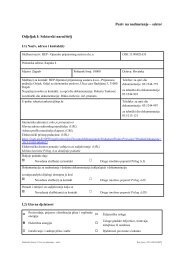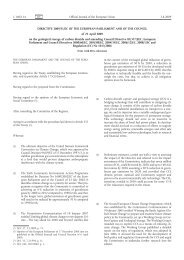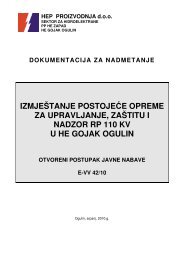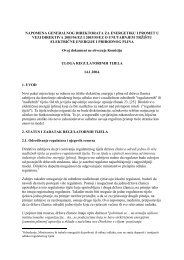DRAVA, KUPA, RJE»INA, LOKVARKA, LI»ANKA LIKA, DOBRA ...
DRAVA, KUPA, RJE»INA, LOKVARKA, LI»ANKA LIKA, DOBRA ...
DRAVA, KUPA, RJE»INA, LOKVARKA, LI»ANKA LIKA, DOBRA ...
Create successful ePaper yourself
Turn your PDF publications into a flip-book with our unique Google optimized e-Paper software.
NOTES TO THE CONSOLIDATED FINANCIAL<br />
STATEMENTS OF THE HEP GROUP (CONTINUED)<br />
FOR THE YEAR ENDED 31 DECEMBER 2010<br />
37. FINANCIAL INSTRUMENTS (continued)<br />
FOREIGN CURRENCY SENSITIVITY ANALYSIS<br />
The Group is mainly exposed to the changes of euro (EUR) and US dollar (USD). The following table details the Group’s<br />
sensitivity to a 10% increase and decrease in the HRK against EUR and USD. 10% is the sensitivity rate used when<br />
reporting foreign currency risk internally to key management personnel and represents Management’s assessment of<br />
the reasonably possible change in foreign exchange rates. The sensitivity analysis includes only outstanding foreign<br />
currency denominated receivables and liabilities and adjusts their translation at the period end for a 10% change<br />
in foreign currency rates. The sensitivity analysis includes external loans where the denomination of the loan is in<br />
a currency other than the currency of the lender or the borrower. A positive / negative number below indicates an<br />
increase in profit and other equity where HRK strengthens 10% against the relevant currency. For a 10% weakening<br />
of the HRK against the relevant currency, there would be an equal effect, but the balance would be negative.<br />
2010 2009<br />
HRK’000 HRK’000<br />
EUR change impact<br />
Profit or loss<br />
USD change impact<br />
350,872 470,385<br />
Profit or loss 38,853 44,809<br />
INTEREST RATE RISK MANAGEMENT<br />
The Group is exposed to interest rate risk as it borrows funds at floating interest rates.<br />
The Group’s exposures to interest rates on financial assets and financial liabilities are shown in section of this<br />
note, the liquidity risk management. The Group manages this risk by maintaining an appropriate mix between fixed<br />
and floating rate borrowings, by the use of interest rate swap contracts.<br />
INTEREST RATE SENSITIVITY ANALYSIS<br />
The sensitivity analysis has been determined based on the interest rate exposure of the Group to financial instruments<br />
at the date of the statement of financial position.. For floating rates, the analysis is prepared assuming the amount of<br />
liability outstanding at the reporting date was outstanding for the whole year. A 50 basis point increase or decrease<br />
is used when reporting interest rate risk internally to key management personnel and represents Management’s<br />
assessment of the reasonably possible change in interest rates.<br />
If interest rates had been 50 basis points higher/lower and all other variables were held constant, the<br />
Group’s:<br />
Profit for the year ended 31 December 2010 would decrease/increase by HRK 21,153 thousand (2009: HRK<br />
-<br />
22,031 thousand), based on exposure to interest rate risk. This is mainly attributable to the Group’s exposure<br />
to interest rates on its variable rate borrowings, which accounted for 77% in 2010 (2009: 73%); and<br />
The Group’s sensitivity to interest rates has decreased during the current period mainly due to the reduction<br />
-<br />
in variable rate of debt instruments.<br />
123<br />
HEP ANNUAL REPORT 2010<br />
CHAPTER 6 - FINANCIAL STATEMENTS



